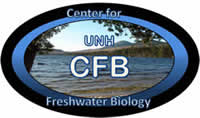Abstract
The study examines the vertical distribution and migratory behavior of net phytoplankton and zooplankton of Mendum’s Pond in Barrington, N.H. The cyanobacteria, Microcystis and Aphanocapsa were the dominant net phytoplankton in this lake. Dominant zooplankton included Daphnia ambigua, Daphnia catawba, Bosmina longirostris, and both calanoid and cyclopoid copepods. Vertical distribution of net phytoplankton suggested migratory behavior, but no consistent pattern was observed. The zooplankton migrated nocturnally, however, calanoid copepods seemed to simultaneously migrate nocturnally and reversely at sunset, suggesting the presence of separate species or different age classes. Diel vertical migration (DVM) of zooplankton was not correlated with the distributions of net phytoplankton in the water column. However, grazing on smaller phytoplankton by zooplankton may have indirectly affected the abundance of the larger size class, net phytoplankton. SONAR analyses suggested that DVM of the phantom midge, Chaoborus, may have influenced the distribution of zooplankton. The findings suggest that a cascading effect of Chaoborus-zooplankton-phytoplankton may pressure vertical distributions of an entire ecosystem of planktonic organisms. Results from the study also raise concern in regard to abundant cyanobacteria and the future trophic status of Mendum’s Pond.
Publication Date
1-1-2006
Publisher
UNH Center for Freshwater Biology Research
Document Type
Article
Recommended Citation
Murby, Amanda L., "Migration of Net Phytoplankton and Zooplankton
in Mendum’s Pond, New Hampshire" (2006). Center for Freshwater Biology. 7.
https://scholars.unh.edu/cfb/7

